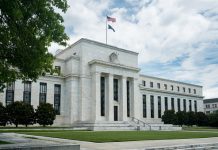Monday was rough across global financial markets. European stocks posted wild slides: the DAX traded nearly 10% lower compared to Friday’s close, the Stoxx 600 dropped more than 6%, the Swiss SMI lost over 5%, and US markets opened sharply down. But suddenly, the trend reversed. Markets rebounded on rumours that Donald Trump could delay part of the tariffs set to kick in tomorrow. The S&P 500 jumped by around 8% on that wave of optimism—only to fall again by 5% as the White House clarified it was all a misinterpretation. In the end, the S&P 500 closed the session with a minor 0.23% dip, and the Nasdaq even eked out a 0.19% gain.
But intraday volatility is at levels not seen since the Covid-era selloff. The VIX index shot up to 60 yesterday. Yes, we briefly touched that level last summer when traders rushed to unwind carry positions, but the feeling on the trading floor was: a day from Covid.
This morning, futures are in better shape—we’re seeing 1–2% gains across Europe and the US—but volatility remains too high to inspire much optimism.
Crazy vol
We’re facing an avalanche of headlines: who’s ready to negotiate, who’s not, what did Trump say, what did he mean… it’s nearly impossible to predict the next move. US Senator Elizabeth Warren called it the “dumbest trade war” in history, pointing out that this turmoil isn’t caused by a virus or a housing collapse—it’s man-made and potentially fixable by simply rolling back tariffs. For now, Trump stands his ground, while world leaders oscillate between retaliation and negotiation. Meanwhile, big investors, US bank bosses, and even Elon Musk—the First Friend—are voicing criticism. Maybe internal pressure in the US will eventually shift the course.
And the Fed?
Of course, the magnitude of this market selloff brings the Federal Reserve (Fed) into the conversation. The central bank is trapped between a rock and a hard place: above-target inflation on one side, rising recession risks on the other. The Fed is being asked to choose—fight inflation or stabilize markets. I believe that if the selloff worsens, the Fed will be forced to prioritize the latter. Market consensus is quietly shifting toward the possibility of four rate cuts this year—double the number expected before Liberation Day.
Bond investors are confused too. Hints of a deal—or even a tariff delay—could spark a risk rebound, leading to a sharp unwinding of dovish Fed bets and renewed selloffs in bonds. BoFA’s MOVE index, which tracks bond market volatility, is surging.
In FX
The US dollar was better bid yesterday, but it’s under pressure again this morning. Trade worries are having the opposite effect of what analysts originally expected. The euro is consolidating just below the 1.10 mark, despite heavy market losses. Some investors argue that an isolated US could actually boost appetite for the euro as a trade and reserve currency. Commodity currencies, however, are suffering: the AUDUSD briefly dipped below 60 cents—the lowest level since Covid. The Chinese, for their part, are letting the yuan weaken to offset tariff-related competitiveness losses.
One hope is that the worst is already priced in and that markets can only rebound from here. But the problem is: the worst keeps getting worse, and there’s no reasonable limit in sight at the White House.











